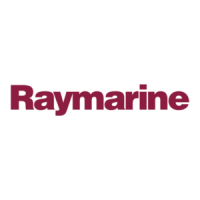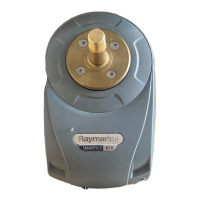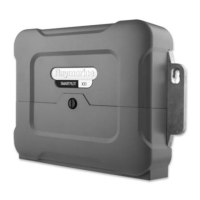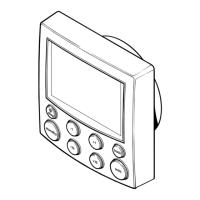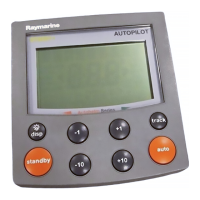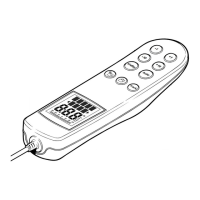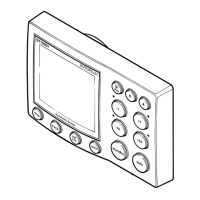Do you have a question about the Raymarine SmartPilot ST6001 and is the answer not in the manual?
Outlines the structure and purpose of the SmartPilot documentation set.
Details compatibility between different SmartPilot controller models.
Provides essential safety warnings and precautions for using the autopilot system.
Cautions regarding correct installation and potential hazards.
Emphasizes safety during electrical connections.
Highlights the necessity of calibration for optimal performance.
Clarifies the autopilot's role as an aid, not a replacement for judgment.
Provides recommendations for ensuring optimal Electromagnetic Compatibility.
Information on using ferrites for EMC performance enhancement.
Guidance for connecting non-Raymarine equipment to the system.
Notes on accuracy and product changes in the manual.
Lists core elements required before system connection.
Describes the computer's function and available models.
Instructions for accessing the computer's connector cover.
Details on selecting cable size and connecting power/drive.
Information on fuses for power and SeaTalk terminals.
Connects compass, rudder sensor, and controller.
Explains connecting SeaTalk controllers and instruments.
Describes connecting NMEA devices like GPS and radar.
Details connecting external components like alarms.
Instructions for securing cables to prevent strain on connectors.
States all autopilot systems need calibration before use.
Details compatibility between different SmartPilot controller models.
Outlines essential pre-seatrial checks performed while docked.
Emphasizes completing dockside checks for safe operation.
Instructions for powering up the SmartPilot system.
Solutions for common problems during system startup.
Procedures for verifying SeaTalk and NMEA data connections.
Verifying NMEA navigator data display on the controller.
Checking SeaTalk or NMEA wind instrument connections.
Verifying rudder position and steering direction.
Checks rudder bar movement against manual wheel input.
Verifies rudder movement direction in auto mode.
Introduction to adjusting core settings via Dealer Calibration.
Step-by-step guide to accessing Dealer Calibration.
Selecting the appropriate vessel type for calibration.
Selecting the correct steering system drive type.
Calibrating rudder bar display for accurate readings.
Setting the maximum rudder travel limits.
Procedures for saving adjusted Dealer Calibration settings.
Explains calibration modes and groups.
Details the four main calibration groups: Display, User, Seatrial, Dealer.
Adjusting display settings and data pages on the controller.
Options for selecting bar graph display and heading format.
Setting the duration for pop-up screens on specific controllers.
Customizing which data is displayed on the controller's pages.
Adjusting settings for changing conditions, e.g., AutoTack, Response.
Calibration specifically for use during the initial seatrial.
Accessing and adjusting settings with significant operational impact.
Steps to enter Dealer Calibration mode for advanced settings.
Overview of Dealer Calibration items and their default values.
Controls access to Seatrial Calibration mode.
Setting the vessel type impacts default calibration values.
Selecting the steering system's drive type.
Calibrating the rudder bar display for accurate readings.
Setting the maximum rudder control limits.
Adjusting how much helm the pilot applies for course correction.
Adjusting rudder to prevent yawing off course.
Adjusting damping to reduce rudder hunting.
Correcting for trim changes using 'standing helm'.
Adjusting course keeping accuracy vs. helm activity.
Limiting the boat's rate of turn under autopilot control.
Setting the angle for the OFF COURSE warning.
Selecting the operating mode for a connected joystick.
Emergency manual override for specific drive types.
Setting the turn angle for automatic tacking (sailboats).
Preventing accidental gybes during AutoTack (sailboats).
Choosing between apparent or true wind for vane mode.
Adjusting response speed to wind direction changes.
Setting default cruise speed for course change calculations.
Compensates for heading errors due to magnetic field dip.
Setting latitude for AutoAdapt compensation.
Resets all calibration settings to factory defaults.
Default values for Dealer Calibration settings by vessel type.
Lists available Dealer Calibration parameters and their options.
Tables of symptoms, causes, and solutions for common issues.
Lists alarm messages and their corresponding causes/solutions.
General maintenance guidelines for Raymarine equipment.
Guidelines for servicing, EMC, and safety precautions.
Information on obtaining customer support via web and phone.
Technical specifications for SmartPilot computers.
Covers outputs, compatibility, drive motor, and NMEA specs.
Outlines the warranty period and coverage.
Explains the process for acquiring warranty service.
Requirements for standard warranty service.
Conditions for receiving warranty service onboard the vessel.
Lists items and conditions not covered by the warranty.
Covers warranty transferability and voiding conditions.
Additional warranty limitations and exclusions.
Contact details for Raymarine support in the Americas.
Contact details for support in other regions.
Outlines the structure and purpose of the SmartPilot documentation set.
Details compatibility between different SmartPilot controller models.
Provides essential safety warnings and precautions for using the autopilot system.
Cautions regarding correct installation and potential hazards.
Emphasizes safety during electrical connections.
Highlights the necessity of calibration for optimal performance.
Clarifies the autopilot's role as an aid, not a replacement for judgment.
Provides recommendations for ensuring optimal Electromagnetic Compatibility.
Information on using ferrites for EMC performance enhancement.
Guidance for connecting non-Raymarine equipment to the system.
Notes on accuracy and product changes in the manual.
Lists core elements required before system connection.
Describes the computer's function and available models.
Instructions for accessing the computer's connector cover.
Details on selecting cable size and connecting power/drive.
Information on fuses for power and SeaTalk terminals.
Connects compass, rudder sensor, and controller.
Explains connecting SeaTalk controllers and instruments.
Describes connecting NMEA devices like GPS and radar.
Details connecting external components like alarms.
Instructions for securing cables to prevent strain on connectors.
States all autopilot systems need calibration before use.
Details compatibility between different SmartPilot controller models.
Outlines essential pre-seatrial checks performed while docked.
Emphasizes completing dockside checks for safe operation.
Instructions for powering up the SmartPilot system.
Solutions for common problems during system startup.
Procedures for verifying SeaTalk and NMEA data connections.
Verifying NMEA navigator data display on the controller.
Checking SeaTalk or NMEA wind instrument connections.
Verifying rudder position and steering direction.
Checks rudder bar movement against manual wheel input.
Verifies rudder movement direction in auto mode.
Introduction to adjusting core settings via Dealer Calibration.
Step-by-step guide to accessing Dealer Calibration.
Selecting the appropriate vessel type for calibration.
Selecting the correct steering system drive type.
Calibrating rudder bar display for accurate readings.
Setting the maximum rudder travel limits.
Procedures for saving adjusted Dealer Calibration settings.
Explains calibration modes and groups.
Details the four main calibration groups: Display, User, Seatrial, Dealer.
Adjusting display settings and data pages on the controller.
Options for selecting bar graph display and heading format.
Setting the duration for pop-up screens on specific controllers.
Customizing which data is displayed on the controller's pages.
Adjusting settings for changing conditions, e.g., AutoTack, Response.
Calibration specifically for use during the initial seatrial.
Accessing and adjusting settings with significant operational impact.
Steps to enter Dealer Calibration mode for advanced settings.
Overview of Dealer Calibration items and their default values.
Controls access to Seatrial Calibration mode.
Setting the vessel type impacts default calibration values.
Selecting the steering system's drive type.
Calibrating the rudder bar display for accurate readings.
Setting the maximum rudder control limits.
Adjusting how much helm the pilot applies for course correction.
Adjusting rudder to prevent yawing off course.
Adjusting damping to reduce rudder hunting.
Correcting for trim changes using 'standing helm'.
Adjusting course keeping accuracy vs. helm activity.
Limiting the boat's rate of turn under autopilot control.
Setting the angle for the OFF COURSE warning.
Selecting the operating mode for a connected joystick.
Emergency manual override for specific drive types.
Setting the turn angle for automatic tacking (sailboats).
Preventing accidental gybes during AutoTack (sailboats).
Choosing between apparent or true wind for vane mode.
Adjusting response speed to wind direction changes.
Setting default cruise speed for course change calculations.
Compensates for heading errors due to magnetic field dip.
Setting latitude for AutoAdapt compensation.
Resets all calibration settings to factory defaults.
Default values for Dealer Calibration settings by vessel type.
Lists available Dealer Calibration parameters and their options.
Tables of symptoms, causes, and solutions for common issues.
Lists alarm messages and their corresponding causes/solutions.
General maintenance guidelines for Raymarine equipment.
Guidelines for servicing, EMC, and safety precautions.
Information on obtaining customer support via web and phone.
Technical specifications for SmartPilot computers.
Covers outputs, compatibility, drive motor, and NMEA specs.
Outlines the warranty period and coverage.
Explains the process for acquiring warranty service.
Requirements for standard warranty service.
Conditions for receiving warranty service onboard the vessel.
Lists items and conditions not covered by the warranty.
Covers warranty transferability and voiding conditions.
Additional warranty limitations and exclusions.
Contact details for Raymarine support in the Americas.
Contact details for support in other regions.
| Display Type | LCD |
|---|---|
| Control Type | Keypad |
| Power Supply | 12V DC |
| Keypad | Yes |
| Waterproof Rating | IPX6 |
| Interface | NMEA 0183 |
| Type | Autopilot Controller |
| Compatibility | Raymarine autopilot systems |
